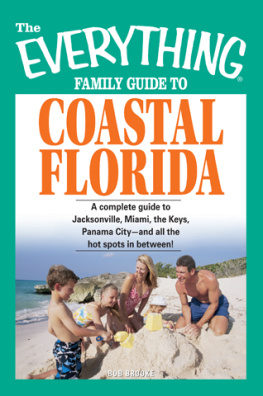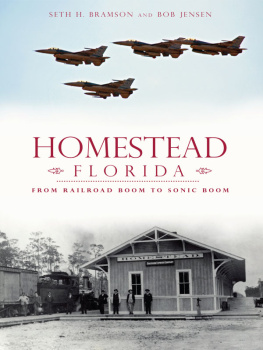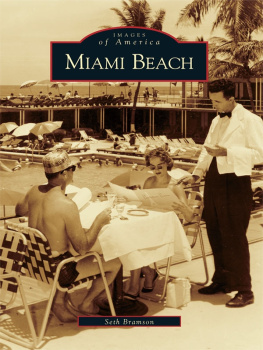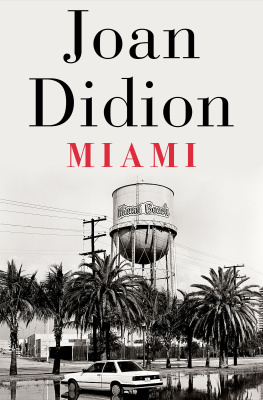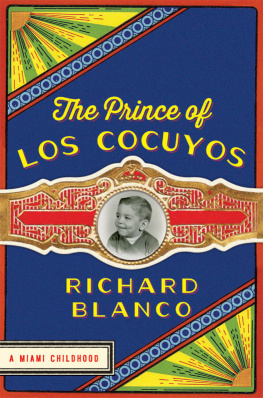Miami and Dade County, Florida
Its Settlement, Progress and Achievement
ETHAN V. BLACKMAN
Miami and Dade County, E. V. Blackman
Jazzybee Verlag Jrgen Beck
86450 Altenmnster, Loschberg 9
Deutschland
ISBN: 9783849649500
www.jazzybee-verlag.de
admin@jazzybee-verlag.de
CONTENTS:
Early History
IN the year 1808 the Spanish government, which at that time owned Florida, granted to John Egan 100 acres of land situated on the Miami River, then known as Sweet Water, where the City of Miami is now located. The grant was made February 27, 1808. Egan disposed of one tract of this land to Frances Lee and the balance to Thomas Gibson. After Florida was ceded to the United States by Spain, James Egan, a son of John Egan, presented claims for 640 acres and his claim was recognized and confirmed by the United States commissioners at St. Augustine. James Egan later conveyed his donation to Richard Fitzpatric, who had also become the owner of the John Egan grant. These two tracts were afterward mortgaged to John Egan's sister, Harriet English, who conveyed the lands to William F. English, who brought here a large number of slaves and commenced extensive farming projects. He farmed a large portion of the hammock and pine lands, his principal crops being cotton, tobacco and indigo. English died without making any disposition of his property and, he being unmarried, the property was equally divided between his mother, Harriet English, and an only brother, John English. Harriet English conveyed her undivided half interest to Dr. J. V. Harris, of Key West. The late Governor William P. Gleason thought he had a claim to some of this property, but the courts decided against him. About this time a company known as the Biscayne Bay Company was organized and George F. Thew, on behalf of the Biscayne Bay Company, purchased the interests of Dr. Harris and the claims of Governor Gleason, which settled the controversy over the titles of these lands. Later Thew conveyed these lands to the Biscayne Bay Company, who, in turn, conveyed them to Frank G. Ford. Ford transferred the property to J. G. Bailey, W. L Wheeless, Joseph Day and George M. Thew. Afterward Joseph Day purchased the interests of his associates and sometime later sold the property to the late Mrs. Julia D. Tuttle. The half interest in this property inherited by John English passed to the heirs of Joseph M. English, Beverly English and Harriet Gillispie and they also conveyed their interests to Mrs. Tuttle. These transactions perfected the chain of titles of these properties in the original grant.
The Perrine Grant
One of the early acts that brought Dade County before the general public was the act of Congress in 1838 which made a grant of one township of land to Dr. Henry Perrine, a noted scientist, for the purpose of introducing purely tropical plants and trees from the tropics. Dr. Perrine had several years' experience in tropical countries and during his residence abroad he became imbued with the idea that in southern Florida the climatic conditions were similar to those in the real tropics, and that if a large number of trees, plants and shrubs could be brought to the United States and successfully grown that it would be a great economic measure, saving the people of the United States millions of dollars each year, besides building up what was then a wilderness. Dr. Perrine, with this thought in view, went before Congress and asked that one township (six miles square) be granted him for this purpose. On July 2, 1838, Congress passed the following Act:
Whereas, in obedience to the Treasury circular of the sixth of September, eighteen hundred and twenty-seven, Doctor Henry Perrine, late American consul at Camp Peachy, has distinguished himself by his persevering exertions to introduce tropical plants into the United States; and
Whereas, he has demonstrated the existence of a tropical climate in south Florida, and has shown the consequent certainty of the immediate domestication of tropical plants in tropical Florida, and the great probability of their gradual acclimation throughout all our southern and southwestern states, especially of profitable plants as propagate themselves on the poorest soil, and
Whereas, if the enterprise should be successful it will render valuable our hitherto worthless soils by covering with a dense population of small cultivators and family manufacturers, and will promote the peace, prosperity and permanency of the Union; therefore.
Be it enacted by the Senate and the House of Representatives of the United States of America, in Congress assembled, That a township of land is hereby granted to Doctor Henry Perrine and his associates in the southern extremity of the peninsular of east Florida, to be located in one body of six miles square, upon any portion of the public lands between 26 degrees north latitude.
Section 2. And be it further enacted, That the said tract of land shall be located within two years from this date by said Henry Perrine, and shall be surveyed under his direction by the surveyor of Florida, provided that it shall not embrace any land having sufficient quantities of naval timber to be reserved to the United States nor any site for maritime ports or cities.
Section 3. That whenever any section of land in said tract shall really be occupied by a bona fide settler, engaged in the propagation or cultivation of valuable tropical plants, and upon proof thereof being made to the Commissioner of the General Land Office, a patent shall be issued to the said Henry Perrine and his associates.
Section 4. And be it further enacted, That every section of land in the aforesaid which shall not be occupied by actual settlers engaged in the propagation or cultivation of useful tropical plants within eight years from the location of said tract, or when the said adjacent territory shall be surveyed and offered for sale, shall be forfeited to the United States.
Before it was possible for Dr. Perrine and his associates to carry out the provisions of this act he was murdered by the Seminole Indians. His widow was unable to carry out the contract or grant provisions made by her late husband. In 1847 Dr. Perrine and his associates selected the lands. The lands were surveyed and designated on the public maps as "Perrine Grant." In 1873 an application was made by the State of Florida to list the lands embraced within the grant to the State under the swamp land act of 1850, which application was refused upon the ground that the lands belonged to the Perrine heirs. Up to this time the Perrines had brought 36 families from the Bahamas, who had settled on lands in the grant. It is claimed that these families, or a major part of them, were driven away by the Indians. On account of the murder of Dr. Perrine, the heirs were not able to carry out the provisions of the grant in full. This caused some litigation, which was finally decided in favor of the Perrine heirs. J. E. Ingraham, vice president of the Florida East Coast Railroad, entered into an arrangement with the Perrine heirs, and the grant was taken over by the railroad company, with Mr. Ingraham as trustee. Later Mr. Ingraham turned the property over to the railroad company. Dr. S. H. Richmond, formerly of Massachusetts, was appointed resident agent for the Perrine grant. Dr. Richmond was a graduate from the Massachusetts Agricultural College, which made him a valuable asset to the settlers who came in from other sections.
Original Dade County
Originally, Dade County on the north commenced on the north side of the St. Lucie River and extended southward to the Monroe County line and westward to the Lee County line, the Atlantic Ocean being its eastern boundary. The geological formation of the original county varied greatly and included Everglade marl, sand prairie, pine land, flat woods, hammock and swales. In the northern part were also many acres of scrub lands. The surface of the lands in the northern part of the county vary greatly from the lands in the central and southern portion of the county. The marl lands in the northern part of the old county are of the same general character as all the marl lands, except that in some parts there is a greater amount of sand mixed with the marl formation. The hammock lands, originally covered with a growth of hardwood timber, were considered of a much richer quality than the other land, except the Everglade and muck pockets. In coming south from Jupiter, the character of the hardwood timber in the hammocks changes. The ordinary hardwood is slightly mixed with some of the more tropical trees, increasing in tropical growth until in the hammocks of Fort Lauderdale the common hardwood varieties disappear entirely and the hardwoods of the tropics take their place. The lands in the northern portion of the county are of the same general formation as those in other portions of the state, but on reaching Fort Lauderdale there is a decided change in the character of the land and the natural wild growth in the hammocks. Here, the coraline rock formation begins to crop out, and in coming southward this rock formation is more pronounced. In some places the entire surface of the land is covered with boulders. In other places the rock is called "pot hole" rock, while in other sections plate rock comes to the surface. The surface rocky lands do not extend far into the Everglades, but at different depths the rock is found, and going westward the dip is greater. The soil overlaying the rock in the Everglades is either sand marl or muck (peat), with here and there small hammock islands where the soil runs from 1 to 20 feet deep over the rock.



